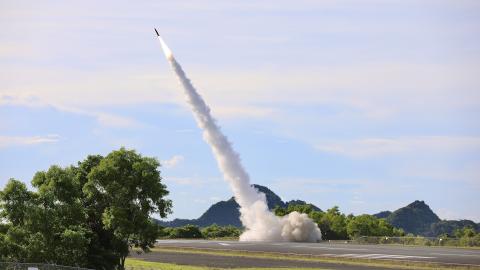The Trump Administration’s approach to arms control was simple. There would be no more one-sided treaties and cheating would not be tolerated. Whether it was the Intermediate Range Nuclear Forces (INF) Treaty or the Open Skies Treaty (OST), rules would be binding, and violations would be punished. No longer would the U.S. remain a party to one-sided treaties that put the U.S. military, as well as our allies and partners, at a disadvantage on the battlefield.
The Trump administration came into office having inherited a world where Russia had a decade head-start in the development of ground-launched missiles with ranges between 500 and 5,500 kilometers. Specifically, the U.S. Intelligence Community assessed that “Russia began the covert development of an intermediate-range, ground-launched cruise missile designated the 9M729 probably by the mid-2000s.”
The United States in 2017 was still bound by the INF Treaty and legally could not “possess, produce, or flight-test” ground-launched missiles with intermediate-ranges. Given the prospects for a theater conflict in Europe post-Russia’s initial invasion of Ukraine in 2014, this was a significant disadvantage for U.S. and NATO forces. Additionally, China was never shackled by such a treaty commitment, giving it a significant military advantage in the Indo-Pacific, possessing thousands of such missiles.
In response, President Trump directed a policy to hold Russia accountable for its violation of the INF Treaty and if we couldn’t force them back into compliance, unshackle the U.S. military. On August 2, 2019, with the full support of our NATO allies, the U.S. withdrawal from the INF Treaty was complete. The race to erase the military advantage accumulated by Russia and China was on. A few short weeks after our withdrawal, the U.S military would test a medium-range missile off the coast of California. A second such test was held at Vandenberg Air Force Base in December 2019. There would be no going back now.
While conducting two such tests of Franken-missiles by the Strategic Capabilities Office was impressive, by no means do they constitute a fielded capability, yet alone a program of record. Given that the U.S. abides by its treaty commitments, we were literally starting from phase-zero in the summer of 2019.
Five short years later, under the cover of darkness on April 11, 2024, a C-17 Globemaster III aircraft touched down in Northern Luzon, Philippines, carrying the Army’s Mid-Range Capability (MRC) missile system. The MRC system is a land-based, ground-launched system, contained in non-descript cargo container launchers that can fire both a Standard Missile 6 (SM-6) and Tomahawk Land Attack Missile (TLAM).
These systems and combinations provide our warfighters with some truly unique and lethal capabilities. The SM-6 for instance is a very versatile munition that can perform anti-air and ballistic missile defense roles. It can also be used to strike ships or land targets. The TLAM also gives the warfighter the ability to strike a similar set of targets. Combined, these munitions hold at risk just about any surface target between approximately 300 and 3,000 kilometers. Capabilities not possible if INF were still in effect.
And make no mistake, China has taken notice. On June, 3, 2024, just a few short months after MRC shows up in the Philippines, Chinese Defense Minister Dong Jun said told Secretary of Defense Lloyd Austin, on the sidelines of the ‘Shangri-La Dialogue’ that “the deployment of US intermediate-range missiles in the Philippines…creates a significant threat to the security architecture in the region...China states its decisive protest." After decades free from a land-based U.S. threat, China should, as the kids like to say, “cry harder.”
If China is upset about this deployment, just wait until the Precision Strike Missile (PrSM) and the Long-Range Hypersonic Weapon (LRHW) start showing up in greater numbers. Both provide a longer strike capability than MRC and have greater ability to penetrate Chinese defenses. PrSM entered low-rate initial production (LRIP) last year and LRHW should be fielded this calendar year. Given the surprise by which MRC showed-up in the Philippines, Xi would be wise to assume that more were on the island than were publicly reported. And he might also assume that PrSM might already be within the theater as well.
Further, there are rumors that Congress may be looking to accelerate the development of the long-range PrSM Inc. 4 and expand production capacity of PrSM Increments 1 and 2 missiles to 500 per year. Senator Roger Wicker’s recently released plan would invest over $200 million for this purpose, and even more for supplier development for Tomahawk and SM-6. There are talks happening with key partners and allies about FMS cases for these capabilities.
Xi is living in a world with increased capability showing up on his doorstep because Vladimir Putin decided to cheat on a treaty and Donald Trump held him accountable. The military capabilities coming on-line now because of a decision made five years ago are vital to deterrence in the South China Sea and Taiwan Strait. Will a handful of these systems in the Indo-Pacific deter Xi – probably not. Will thousands of such missiles – it just might. It’s time to go faster and accelerate their production.



















